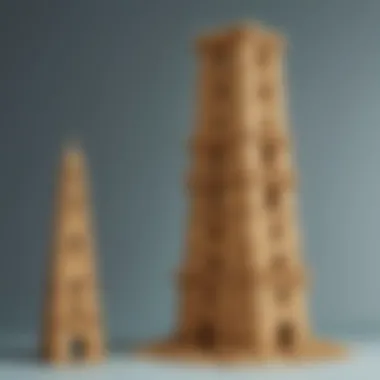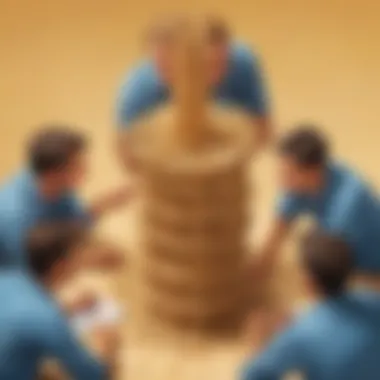Exploring the Straw Tower Team Building Activity


Intro
In the realm of educational activities, the Straw Tower Team Building Activity stands out as a unique and engaging challenge. It expertly combines creativity with the practical aspects of teamwork while fostering problem-solving skills among participants. Whether you're a teacher looking to spice up your lesson plans or a parent seeking enriching activities for your children, this hands-on project fits the bill nicely.
This activity involves groups working together to construct a tower using nothing but drinking straws and tape. Simple in concept, it's a remarkable vehicle for deeper learning. It's more than just a craft; it is an exercise in collaboration, communication, and critical thinking. With the growing emphasis on interactive learning games, the Straw Tower Activity showcases how play can integrate educational objectives seamlessly.
Understanding the complexities and joys of team dynamics is crucial for children’s development. This guide will dig into the nuts and bolts of the Straw Tower Team Building Activity, from understanding its objectives to exploring materials and strategies that enhance the experience. The aim is to inspire curiosity, collaboration, and creativity in various educational settings.
Interactive Learning Games
Engaging children in interactive learning games is essential for an enjoyable educational journey. By balancing fun with teaching moments, kids can learn concepts naturally.
Popular Games
With the multitude of educational games available, some stand out due to their effectiveness. Games like Capture the Flag, Scavenger Hunts, and even digital options, such as coding games, help in various skills development while keeping kids invested.
Description of Top Educational Games
- Straw Tower Challenge: This game emphasizes teamwork, communication, and engineering skills, aligning perfectly with the objectives of the Straw Tower Activity.
- Math Bingo: This adds a fun twist to math, giving kids the opportunity to practice their skills in a competitive setting.
- Science Jeopardy: Engaging students in a quiz format makes learning complex scientific concepts more approachable.
Benefits of Playing Educational Games for Kids' Cognitive Development
Playing educational games enhances several cognitive abilities in children:
- Critical Thinking: Tasks such as planning, analyzing, and executing strategies are fundamental in many games.
- Creativity: Innovating solutions during gameplay sparks creative thought.
- Social Skills: Games encourage interaction, helping children learn to work and communicate effectively in groups.
Game Reviews
An in-depth look at a few selected educational games may highlight their individual strengths:
- Straw Tower Challenge: Participants discover how to manage materials efficiently while learning physics principles, all within a time limit which sharpens decision-making skills.
- Math Bingo: Reviews show that kids find this game both exciting and educationally beneficial, particularly for memorizing mathematical facts.
- Science Jeopardy: A favorite among educators, it fosters a competitive spirit while cementing knowledge in fun ways.
Comparison of Gameplay and Learning Outcomes
When contrasting different games it’s clear they deliver on various educational fronts. While the Straw Tower activity develops tangible skills like engineering and teamwork, Math Bingo serves primarily for cognitive development in mathematics. Science Jeopardy stands out as an engaging review method for comprehensive learning.
"The right educational games can transform a mundane learning experience into an exciting expedition filled with discovery and collaboration."
This connection between structured play and learning is well supported, bringing us back to the importance of participatory activities like the Straw Tower Challenge.
Prelims to Team Building Activities
In today’s education landscape, fostering collaboration among students is a cornerstone of effective learning. Team building activities, like the straw tower challenge, are not mere games; they are vital tools that enhance interpersonal skills among children. When various minds collaborate toward a common goal, a transformation occurs—students not only learn to communicate better but also develop resilience and creativity.
Defining Team Building
Team building refers to a variety of activities designed to enhance social relations and define roles within teams. It encourages participants to work together towards a shared objective, often emphasizing collaboration and cooperation. In essence, it’s about bonding while accomplishing tasks. Feels like a simple concept, but consider how it influences sticky situations. For instance, when a teacher guides children to construct a tower out of straws, they might experience both successes and failures. Navigating these moments requires communication and trust, which are the very essence of effective teamwork.
Importance in Educational Contexts
In educational settings, team building activities have become increasingly important. They serve as a practical framework for students to learn life skills in a controlled environment. Through activities aimed at promoting teamwork, children gain insights into their peers’ strengths and weaknesses.
- Cultivating Communication Skills: Engaging in team-oriented tasks teaches students the importance of verbally expressing ideas and concerns. They learn not only to listen but to respond effectively.
- Developing Leadership Qualities: As students work together, natural leaders often surface, providing opportunities for others to follow their lead or develop their authority without formal titles.
- Enhancing Problem-Solving Abilities: Encountering obstacles during activities forces teams to brainstorm solutions collectively. This cultivates critical thinking skills that are indispensable in today's world.
"It's not about getting the work done; it's about the lessons learned along the way."
Overall, the importance of team building in educational contexts cannot be overstated. It's an investment in students' futures, making them not just better learners, but also better individuals.
The Straw Tower Activity Explained
The Straw Tower activity stands out as a unique team-building exercise, providing numerous benefits for participants while fostering an environment of creativity and collaboration. This playful yet educational experience encourages groups to brainstorm and utilize their collective strengths to construct a tower made primarily of straws and other basic materials.
In today's fast-paced world, where teamwork can often get sidelined, engaging in such activities reinforces the vital skills of communication and problem-solving among participants. Here’s a closer look at its components:
Overview of the Activity


The Straw Tower activity is not just a test of engineering skills, but also one of group dynamics and strategy. Groups are tasked with building the tallest structure they can using only a limited set of materials such as straws, tape, and scissors. This constraint ignites creativity, prompting participants to think outside the box, often leading to unexpected and innovative designs. Each session typically lasts between 30 minutes to an hour, depending on the group size and the complexity desired.
Participants work together, discussing ideas and implementing them into their designs, which fosters an environment where everyone feels their contribution is valuable. The challenge is approachable yet engaging, offering an excellent mix of fun and educational outcomes.
Objectives of the Activity
The main objectives of the Straw Tower activity revolve around several key points that are crucial in educational settings:
- Enhancing Teamwork: Encourages collaboration as students must combine efforts to create a cohesive structure.
- Boosting Problem-Solving Skills: Participants face challenges that require critical thinking and adaptive reasoning.
- Encouraging Communication: Open dialogue is necessary for a successful strategy, helping participants articulate their thoughts clearly to the group.
- Stimulating Creativity: Using simplistic materials forces teams to innovate, leading to diverse and creative solutions.
- Fostering Resilience: Through trial and error, participants learn that failure can be a stepping stone to success.
These objectives are designed to be educational while also ensuring participants enjoy their time together, making it a worthwhile experience for both learners and facilitators.
Target Age Group and Suitability
This activity is remarkably versatile and can be adapted for various age groups, making it valuable in different contexts.
- Primary School Students (Ages 6-11): Younger children can engage in basic structure building, with guidance to support their understanding of teamwork and communication.
- Middle School Students (Ages 12-14): As cognitive skills mature, these students can tackle more complex designs, introducing elements of physics and engineering.
- High School Students (Ages 15-18): Older teens can engage in deeper discussions about design and construction principles, enhancing their analytical skills.
- Adults: Professional groups can derive substantial insights into leadership styles, collaboration, and strategic thinking during such exercises.
The adaptability of the Straw Tower activity makes it a valuable tool in fostering a range of life skills across different educational settings and age groups.
Building a tower out of straws might sound simple, yet it uncovers layers of teamwork that one doesn't always see in conventional settings.
Materials Required for the Straw Tower Activity
The materials needed for the straw tower activity serve as the backbone of the entire exercise. They not only direct young minds toward practical application but also ensure that the activity remains engaging and effective. This section brings to light the essential components that make the exercise come to life, as well as alternative items that might spur creativity beyond the standard offerings. Understanding the materials involved is paramount for both facilitators and participants, intertwining fun with learning.
List of Essential Materials
Here’s a rundown of the main materials that you simply can't do without:
- Drinking Straws: These are the heart of the activity. Flexible, lightweight, and versatile, they serve as building blocks in construction.
- Masking Tape: Essential for binding your straw structures together. Use it liberally, as it can secure your tower's integrity.
- Scissors: Not just to cut tape, but to customize straws if needed, making them the right length for your creation.
- Ruler: Handy for kids who want to measure their tower, ensuring it's a fair competition.
- Timer: Helps to keep track of time, adding an exciting race element to the construction phase.
Think of these items as the standard toolkit for budding architects. Each element plays a crucial role and makes the exercise possible.
Alternative Materials for Creative Exploration
But who says you have to stick to the basic toolkit? Here’s where creativity can run wild. Think outside the box with:
- Pipe Cleaners: Great for designing intricate connections between straws that add flair and stability at the same time.
- Cardboard Bases: Offering a sturdy foundation for your tower can help it reach dizzying heights without toppling over.
- Rubber Bands: These can be substituted for tape in some cases, adding a fun twist in attachment methods.
- Wooden Skewers: Stronger than straws; they might allow for a taller, more resilient structure if you dare to swap them in for straws.
- String or Yarn: Perfect for a more artistic touch, you could tie straws together for unique designs and even stability.
The beauty of the straw tower activity is that the materials can be adapted, ensuring no two projects look alike. Varying the materials means opening the floor to imaginative engineering while still driving home essential skills.
"Creativity is intelligence having fun."
— Albert Einstein
By promoting a culture of experimentation using different materials, you'll not only keep the excitement alive but also encourage critical thinking. In the end, while the essential materials are indispensable, the alternatives pave the way for limitless exploration and learning.
Preparation Steps for Facilitators
Preparation before executing the straw tower activity is crucial for ensuring a smooth and effective experience for participants. This section delves into setting up the space and clearly explaining the rules and guidelines—two key elements that significantly enhance the activity's impact.
Setting Up the Space
The area where the straw tower activity takes place should be conducive to collaboration and creativity. It’s advisable to select a spacious indoor or outdoor location that accommodates all participants comfortably. Here are some considerations when setting up:
- Layout: Arrange tables or designated workspaces to facilitate teamwork. A circular or semi-circular setup helps foster interaction.
- Accessibility: Make sure all materials are easily reachable for every group. This saves time and keeps the momentum going.
- Safety: Check the space for any potential hazards. Ensure there are no obstacles that could cause accidents as teams build their towers.
"A well-organized space lets creativity flow freely. It's like giving teams a blank canvas to work their masterpieces!"
Moreover, it might be beneficial to have a designated area for completed towers—this keeps everything organized and allows teams to showcase their achievements. If it’s an outdoor setting, ensure the weather isn’t going to be a spoilsport. Depending on the number of participants, you might want to have several spaces to avoid overcrowding, which can lead to chaos.
Explaining the Rules and Guidelines
Once the space is prepared, clearly explaining the rules and guidelines becomes essential. This part sets the tone for the entire activity. Here are some points to include in your brief:
- Objective: Convey the main goal—construct the tallest free-standing tower using only the provided materials. Making this clear encourages focused teamwork.
- Materials: Briefly go over what they are allowed to use, ensuring teams know the limits and creative scope available.
- Time Limit: Setting a specific time frame creates a sense of urgency and excitement. Keeping teams on their toes helps to enhance their focus.
- Team Roles: If desired, suggest specific roles within groups, such as designer, builder, and presenter, to encourage collaboration among diverse skill sets.
- Safety Precautions: Remind participants to handle materials responsibly, ensuring a safe building environment.


Adding a little background on the importance of teamwork can motivate participants. Frame the activity not just as a building exercise but as a means to cultivate traits like leadership, cooperation, and resourcefulness. By clarifying the expectations upfront, participants can dive into their projects with a shared understanding, maximizing their collective potential.
Executing the Activity
When it comes to executing the straw tower activity, several key factors come into play. This stage is where all the planning, preparation, and excitement culminate. The importance of executing this activity lies not only in building the towers but also in fostering essential life skills that will serve children beyond the classroom.
Team Formation Strategies
Creating effective teams is crucial to the success of the straw tower activity. Team formation can set the tone for collaboration and engagement. One effective strategy is to mix different skill sets. For instance, pairing a child who excels in engineering concepts with someone more creatively inclined can create a balanced team. This balance often leads to innovative solutions that may not arise in more homogenous groups.
- Consider Size of Teams: Smaller teams of four or five can facilitate better communication.
- Include Diverse Roles: Assign roles based on individual strengths—such as designer, builder, and timekeeper—to give each child a sense of ownership over the process.
- Promote Randomization: Sometimes, forming teams randomly can create unexpected dynamics that enhance teamwork skills.
Time Management During Construction
Time is often the silent player in group activities. Teaching children to manage their time effectively can greatly influence their project outcome. It’s beneficial to establish clear time limits for each segment of the building process. Here’s how to approach this:
- Set Clear Milestones: Divide the activity into phases, like "design phase" and "building phase." By pacing the activity, children can better allocate their time and avoid last-minute rushes.
- Use Timed Checkpoints: Introduce short breaks to assess progress. Ask teams to reflect on their plans and adjust accordingly, which can lead to deeper learning.
- Encourage Planning: Provide teams with a simple planning sheet to sketch their tower. This can streamline their efforts and help them focus.
Encouraging Creative Solutions
Creativity is often at the heart of what makes the straw tower activity exciting and educational. Encouraging children to think outside the box can lead to unique solutions and strategies. Here’s how to facilitate creative thinking during the activity:
- Foster a Safe Environment: Make it clear that every idea is worth discussing. This can eliminate the fear of failure and encourage children to share their imaginative concepts freely.
- Provide Examples: Sometimes, showing images of interesting tower designs can inspire children without dictating a specific solution.
- Challenge Existing Ideas: Encourage groups to continuously question their methods and materials. Asking questions like, "How can we improve stability?" may lead them to rethink their design.
Creativity is about connecting ideas and thinking divergently. The more practice children get, the easier this becomes.
Executing the straw tower activity is a vital phase that incorporates planning, teamwork, and creativity. When done thoughtfully, this activity not only builds towers but also erects lasting skills in collaboration, critical thinking, and time management—assets that will support children throughout their lives.
Learning Outcomes from the Activity
The straw tower team building activity is not just a fun way to spend an afternoon. It serves as a valuable pedagogical tool with multiple learning outcomes for participants. Each child’s experience in building their straw tower extends their skill set in various domains, including critical thinking, problem solving, and teamwork. This section unfolds the rich tapestry of benefits this activity offers.
Enhancing Problem-Solving Skills
At its core, the straw tower activity is a challenge that requires participants to think critically and address issues as they arise. As children collaborate to design and construct their towers, they face obstacles such as structural stability and resource limitations. This real-time problem-solving cultivates resilience and adaptability. For instance, if one team member suggests a design that’s not feasible, others must brainstorm alternative approaches.
Engagement in this process arms them with techniques to tackle not only construction challenges but also everyday problems they might encounter in life. They learn how to assess a situation, analyze available options, and implement solutions effectively. This exercise effectively mirrors the problem-solving approaches needed in academics and beyond, highlighting its relevance in educational settings.
Promoting Teamwork and Communication
Building a straw tower isn’t a solo venture; it’s a team effort requiring effective communication and collaboration. Children learn to express their ideas, listen to others, and negotiate differing opinions. This dynamic interaction fosters a sense of community, even among competing teams.
The ability to work in teams is crucial for future endeavors, be it in school projects or professional environments. As participants share responsibilities—whether it's gathering materials or ensuring structural integrity—they develop an appreciation for diverse roles within a group setting. Encouraging dialogue, this activity trains them to articulate thoughts respectfully, thus enhancing their social skills.
Encouraging Creativity and Critical Thinking
Creativity flows naturally when the only limits are the materials at hand. In the straw tower activity, children are given free rein to devise imaginative designs, leading to unique structures. This fosters an environment where out-of-the-box thinking is not just welcomed but essential.
Critical thinking comes into play as children evaluate which ideas might work or fail. They learn to predict outcomes, prepare for potential pitfalls, and assess designs after construction. For example, if a tower falls, participants must consider what went wrong and what they can change for their next attempt. This iterative process is invaluable—both in creative pursuits and in systematic reasoning across various disciplines.
"Learning is not a spectator sport; participants learn from trial, error, and success—all wrapped in the fun of competition."
By encouraging a mix of imaginative design and practical reasoning, the straw tower activity serves as a microcosm of larger educational goals—promoting not just creative expression, but also analytical prowess. This balance is what makes the activity compelling for children as they navigate both art and science in the pursuit of building their towers.
Challenges and Considerations
Focusing on challenges and considerations during the Straw Tower activity is crucial. No matter how well-structured a team-building exercise might be, hurdles often present themselves along the way. Understanding these challenges can not only help facilitators prepare but also enhance the experience for everyone involved. Being aware of potential issues can also lead to better resolutions, ensuring teams can adapt and evolve.
Potential Issues During Execution
While the aim of the Straw Tower activity is to foster creativity and collaboration, certain issues could arise during its execution. Here are some examples of those potential pitfalls:
- Material Limitations: Sometimes, the straws or other items provided may not be sufficient for the ideas that participants envision, leading to frustration. If teams don't have enough to work with, creativity may suffer.
- Time Management: A common problem is misjudging the time needed for construction. Teams might spend too much time planning and not enough executing, which can be counterproductive.
- Conflict Among Team Members: Ideally, this activity promotes teamwork. However, it can also bring underlying tensions to the surface. Disagreements over ideas or methods could hinder progress and create a negative atmosphere.
- Lack of Engagement: If some team members are not fully involved, the whole group's dynamic can be compromised. Certain individuals may dominate discussions or avoid participation, affecting overall collaboration.
"Facing challenges is a part of growth; sometimes, overcoming them is the best lesson of all."


Strategies for Overcoming Obstacles
It's vital for facilitators to have strategies ready to tackle potential issues. Here are some effective ways to overcome these challenges:
- Ensuring Sufficient Materials: Always prepare extra straws and alternative materials in advance. This step can prevent supply shortages that may stifle creativity.
- Setting Clear Time Frames: Break the activity into distinct phases with set times for each. This can help teams manage their construction and encourage a sense of urgency while still allowing for creativity.
- Mediating Conflicts: As a facilitator, be prepared to step in and mediate if disputes arise. Encourage open communication by allowing team members to voice their ideas, ensuring everyone feels heard and valued.
- Fostering Inclusion: Use a variety of engagement techniques. For instance, assigning roles or rotating tasks can keep everyone involved and engaged. Keeping the lines of communication open is vital for a successful group dynamic.
By being aware of these challenges and employing effective strategies, facilitators can ensure that the Straw Tower activity is not only educational but also enjoyable for all participants.
Reflection and Debriefing
When it comes to activities like the straw tower team building exercise, reflection and debriefing aren’t just flavorings added to the meal; they’re the main course. After all the hard work and creativity that participants put into building the most impressive towers, taking the time to dig deeper into the experience can significantly enhance learning outcomes. The value found in reflection is manifold. It helps individuals consolidate their understanding of concepts while also fostering emotional intelligence within the team.
Reflection also provides a platform for participants to explore what they’ve learned, both personally and collectively. The process allows children and adults alike to voice their thoughts, experiences, and lessons. By discussing what went well, what didn’t, and why certain strategies were successful or failed, everyone becomes clear on not just the ‘how’ but also the ‘why’ behind their efforts. This is where the real insights can emerge.
Furthermore, conducting a debrief allows practitioners to emphasize critical skills gained during the activity. Attributes like leadership, collaboration, and adaptability become clearer in the minds of participants when brought to light in a thoughtful discussion.
Importance of Reflection After Activity
The essence of reflection lies in its ability to sink deep roots into the participants’ minds. Here are some key reasons why it is essential:
- Consolidation of Learning: Reflection allows participants to connect their practical experiences with theoretical concepts. They can link hands-on tasks to classroom learning, making the lessons more tangible and relevant.
- Emphasis on Team Dynamics: Analyzing how well they communicated, collaborated, and resolved conflicts during the activity can significantly enhance future team interactions. Participants learn about their roles within a group setting and how their actions affect others.
- Encouragement of Self-Assessment: Reflecting fosters a habit of self-evaluation, helping individuals think critically about their strengths and areas for improvement. This can also encourage a growth mindset, nurturing resilience and adaptability.
Importantly, taking a moment to connect findings from the activity to personal experiences enriches each participant's journey.
Facilitating a Group Discussion
Creating an effective group discussion after the straw tower activity is crucial for maximizing the reflection process. Here are several strategies to keep in mind when guiding this essential conversation:
- Create a Safe Space: Encourage openness by establishing an environment where all ideas and feelings are valued, making it clear that it's okay to express confusion or disappointment along with success.
- Use Open-Ended Questions: Questions should be constructed to allow deeper thinking. Consider asking, "What strategies did your team employ, and how did they evolve throughout the activity?" or "How did your approach change when faced with challenges?"
- Highlight Specific Examples: Encourage participants to share specific instances from the activity. This not only keeps the discussion grounded in reality but also situates personal experiences within a broader context.
- Encourage Peer Feedback: Allow participants to give and receive constructive feedback from one another, fostering a sense of community and collective learning.
- Summarize Insights: Wrap up discussions by summarizing the main takeaways. Asking participants to share one thing they will carry forward into future activities solidifies their learnings.
"Without reflection, we merely do; we don’t understand. Understanding is the cornerstone of growth."
Books and Articles on Team Building
Diving into literature can be incredibly valuable for anybody looking to bolster their understanding of team dynamics. Books such as "The Five Dysfunctions of a Team" by Patrick Lencioni present a compelling look at the mechanics of effective teamwork. Articles published in educational journals often spotlight innovative approaches to activities like the straw tower, laying out case studies and strategies that have proven successful in various settings. Reading widely can immerse the facilitator in different perspectives, often tying in theories from psychology and education. This can enhance their ability to guide participants in a way that’s not only instructional but transformative.
- Essential Reads:
- "The Five Dysfunctions of a Team" by Patrick Lencioni
- "Creative Confidence" by Tom and David Kelley
- Articles from educational journals such as Educational Leadership
Consider keeping a library of these works accessible. Digging into these resources can inspire fresh ideas and adaptability when running the straw tower activity. The varied insights gleaned can help tailor the experience to suit specific age groups or educational goals, enriching the overall learning journey.
Online platforms for Continuing Learning
In today’s digital age, online platforms are a boon for continuous professional development. Websites like edX and Coursera offer a plethora of courses dedicated to team building and educational leadership. These platforms not only provide the latest research but also cover a range of pedagogical strategies, making it easier to sprinkle in new approaches during the straw tower activity.
- Recommended Platforms:
Furthermore, engaging in online discussions, perhaps on Reddit or dedicated Facebook groups, can lead to real-time exchanges of ideas. The vibrant community of educators willing to share experiences and tips can serve as a rich resource pool. By networking with fellow facilitators, one can discover unique twists to the straw tower activity or strategies for overcoming common challenges faced during the execution.
Utilizing these additional resources not only deepens one’s own understanding but also enriches the learning experience for all participants, making the journey through the straw tower activity one of growth, creativity, and connections!
The End
The conclusion serves as a vital closing chapter in understanding the Straw Tower team building activity. This segment is where all the pieces of the puzzle come together, reflecting on the relevance of the activity within educational contexts and its extensive benefits.
At its core, the Straw Tower activity encourages collaboration, strengthens communication skills, and enhances creativity among participants. These essential life skills not only contribute to personal development but also enrich any group dynamic. Children learn to appreciate diverse perspectives, thus fostering a sense of belonging and camaraderie. As they work through challenges together, they develop an understanding of the importance of patience and perseverance, essential traits that reach beyond the classroom walls.
Moreover, the activity provides educators and facilitators with insights about their students' strengths and areas for growth. This newfound awareness can guide future group endeavors, tailoring experiences to nurture individual abilities while promoting teamwork. The benefits are manifold: cultivating critical thinking, boosting morale, and laying a strong foundation for future collaborations.
In sum, recognizing the multifaceted benefits of the Straw Tower activity is crucial for educators, parents, and caregivers. Implementing this activity not only engages children in a fun and constructive manner but also empowers them with skills that will serve them well in their educational journey and beyond.
Recap of Key Points
- Team building activities, like the Straw Tower, enhance cooperation among children.
- This activity significantly promotes communication skills and encourages creative thinking.
- Reflecting on group dynamics helps educators tailor future activities to foster growth.
- The experience nurtures perseverance and patience, essential traits for students' personal development.
Encouragement to Implement Team Activities
There's no better time than now to integrate team-building activities like the Straw Tower into learning environments. Such activities are invaluable tools to bridge gaps, connect with students, and create an inclusive atmosphere.
The process of building a straw tower, while seemingly simple, opens doors to meaningful discussions about strategy, goal-setting, and working harmoniously with others.
By fostering these experiences, educators not only enhance learning outcomes but also instill a deeper appreciation for collective effort. As children tackle obstacles together, they build confidence and enthusiasm for future collaborations, whether in school or within their social circles.
Incorporating team-building activities enriches both the educational experience and the personal growth paths of young learners.















